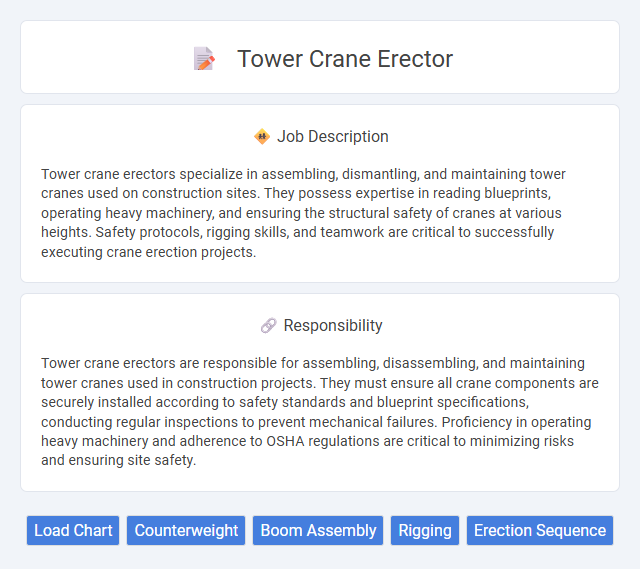
Tower crane erectors specialize in assembling, dismantling, and maintaining tower cranes used on construction sites. They possess expertise in reading blueprints, operating heavy machinery, and ensuring the structural safety of cranes at various heights. Safety protocols, rigging skills, and teamwork are critical to successfully executing crane erection projects.
Individuals with strong physical endurance and good balance are likely suitable for a tower crane erector job due to the demanding nature of the work, which often requires working at great heights and handling heavy equipment. Those who are comfortable with heights and have a keen attention to safety protocols may find increased success and satisfaction in this role. People with limited physical stamina or a fear of heights might face challenges in performing the essential duties effectively.
Qualification
A Tower Crane Erector must possess extensive knowledge of construction safety standards, rigging techniques, and mechanical systems. Certification in crane operation and OSHA safety training are essential qualifications, alongside physical stamina and the ability to work at significant heights. Experience with assembly, disassembly, and maintenance of tower cranes is critical for ensuring structural stability and safe operation on construction sites.
Responsibility
Tower crane erectors are responsible for assembling, disassembling, and maintaining tower cranes used in construction projects. They must ensure all crane components are securely installed according to safety standards and blueprint specifications, conducting regular inspections to prevent mechanical failures. Proficiency in operating heavy machinery and adherence to OSHA regulations are critical to minimizing risks and ensuring site safety.
Benefit
Working as a Tower Crane Erector likely offers significant financial benefits due to the specialized skills required and the high demand in construction projects. The role may provide opportunities for career advancement and certification that enhance long-term earning potential. Job stability and benefits such as health insurance and retirement plans are also probable in many companies within this industry.
Challenge
Tower crane erectors likely face significant challenges requiring precision and safety awareness when assembling towering machinery in various weather conditions. The complexity of lifting heavy components into place while ensuring structural stability may demand strong technical skills and effective teamwork. This role probably involves high physical and mental demands, increasing the importance of rigorous safety protocols to minimize risks on construction sites.
Career Advancement
Tower Crane Erector positions offer significant career advancement opportunities through gaining expertise in heavy machinery assembly, rigging, and safety protocols. Progression often leads to senior roles such as Crane Supervisor, Site Manager, or specialized technician, with increased responsibilities and higher wages. Certifications and hands-on experience in complex crane setups enhance employability and open pathways to leadership within construction and infrastructure projects.
Key Terms
Load Chart
A Tower Crane Erector relies heavily on the load chart to ensure safe and efficient crane assembly and operation. The load chart provides critical data on the maximum lifting capacity at various boom lengths and angles, guiding the erecting process and load handling. Accurate interpretation of load charts prevents overloading, maintaining structural integrity and compliance with safety regulations on construction sites.
Counterweight
A Tower Crane Erector is responsible for the precise installation and secure placement of counterweights, which are essential for stabilizing the crane during lifting operations. Counterweights typically consist of heavy concrete or metal blocks strategically positioned to balance the load and prevent tipping. Mastery in handling and assembling these critical components ensures safe and efficient tower crane functionality on construction sites.
Boom Assembly
Tower crane erectors specialize in the precise assembly of boom sections, ensuring structural stability and optimal load distribution. Mastery in aligning and securing telescopic and lattice boom components is crucial for safe crane operation at construction sites. Proficient use of rigging equipment and adherence to safety protocols minimize risks during boom assembly processes.
Rigging
Tower crane erectors specialize in rigging heavy components to ensure safe and precise assembly at construction sites. They use advanced rigging techniques and equipment such as slings, shackles, and hoists to lift and position tower crane sections. Expertise in load calculations, safety protocols, and structural stability is critical for preventing accidents during crane erection.
Erection Sequence
The Tower Crane Erector expertly follows a precise erection sequence to ensure safe and efficient assembly of tower cranes on construction sites. This sequence involves rigging the base, securing the mast sections, installing the slewing unit, and finally positioning the jib and counterweights with exact calibration. Strict adherence to manufacturer specifications and safety protocols during each step minimizes risks and guarantees operational stability for the crane's full service life.
 kuljobs.com
kuljobs.com